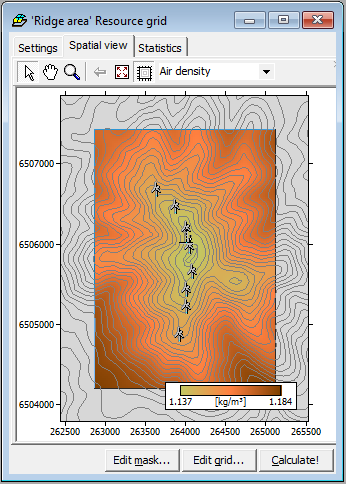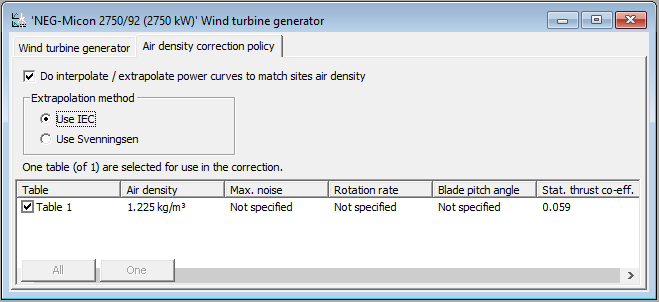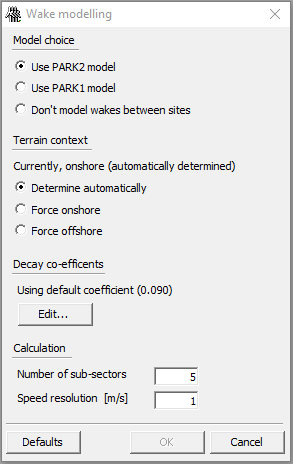In addition to the new features of WAsP 12, outlined below, with this release we introduce a new licensing structure for WAsP software. WAsP is now bundled with WAsP Engineering and Windfarm Assessment Tool, and sold by an annual subscription fee.
In WAsP 12 we introduce automatic calculation of site-specific air density, as well as automatic air density correction of power curves.
Based on the geographic location of the site, WAsP 12 applies barometric reference information (from CFSR reanalysis data) and the on-site elevation variations of the terrain to estimate the mean air density across the site — and specifically at the hub height of each wind turbine.

Subsequently, WAsP 12 uses the estimated air densities at the hub height of each wind turbine to interpolate between, or extrapolate from, the power curve(s) specified in the wind turbine generator file. For power curve extrapolation, WAsP 12 offers to use either the IEC extrapolation method (as described in the international standard IEC 61400-12-1) or the Svenningsen extrapolation method (adjusted IEC extrapolation method, improved to match turbine control).

More information about the Svenningsen extrapolation method can be found in the abstract/poster “Proposal of an Improved Power Curve Correction”, presented by Lasse Svenningsen (EMD International A/S) at the European Wind Energy Conference & Exhibition 2010 in Warsaw.
WAsP 12 also includes a revised version of the PARK wake model.
In the revised PARK model (PARK2), we introduce a consistent formulation for the wind speed deficit in the wakes. In addition, a more physically based linear superposition rule is introduced. Moreover, for aerodynamic reasons, wake reflection from the terrain surface is omitted. For reference, the old PARK model (PARK1) is also included in WAsP 12.
For offshore conditions, the PARK2 model has been evaluated and calibrated against a number of data sets of actual power production from offshore wind farms. The calibration resulted in a recommended/default value for the wake decay constant. With this wake decay constant, PARK2 was found to produce calculations closer to actual power productions of the offshore wind farms. Therefore, DTU Wind Energy recommends the use of PARK2 with this new default wake decay constant for offshore calculations.
For onshore conditions, actual power production data from large wind farms were not available to us. Consequently, for onshore conditions PARK2 has been calibrated against PARK1 calculations of annual energy production in order to determine a recommended/default value for the wake decay constant.

More detailed information about the revised version of the PARK model can be found in the paper “Validation of the revised PARK model”, presented by Ole S. Rathmann (DTU Wind Energy) and others at the WindEurope Conference & Exhibition 2017 in Amsterdam.
With release of WAsP 12 we have switched to a WAsP Bundle license, which is now sold by a EUR 650 annual subscription fee.
For new subscribers, there is an additional EUR 1300 signup fee. However, signup is free for WAsP 11 and WAsP Engineering 4 users until May 2018. For more information and for ordering your WAsP Bundle license, please refer to www.wasp.dk/products.
The new WAsP Bundle license gives access to the newest versions of WAsP, as well as WAsP Engineering and Windfarm Assessment Tool, including electronic help facilities and online documentation, as well as sample data and quick start tutorials. Online forums and e-mail support are also included with the license. Data tools like the WAsP Climate Analyst and the WAsP Map Editor continue to be freeware.
The new WAsP Bundle license also includes access to WAsP and WAsP Engineering developer APIs. This allows you to do WAsP and WAsP Engineering calculations without the user interfaces, by calling the same objects that the user interfaces use. In this case, you can write code inside e.g. an MS Excel workbook, which loops over different projects, updates files, performs calculations and collates the results in the spreadsheet. It is extremely flexible, and not much more complicated than writing a script to run inside the program.
DTU Wind Energy can help with doing some custom programming work to get you started. Such work would be charged at our hourly rate for commissioned work and would need to be agreed upon by prior written agreement.